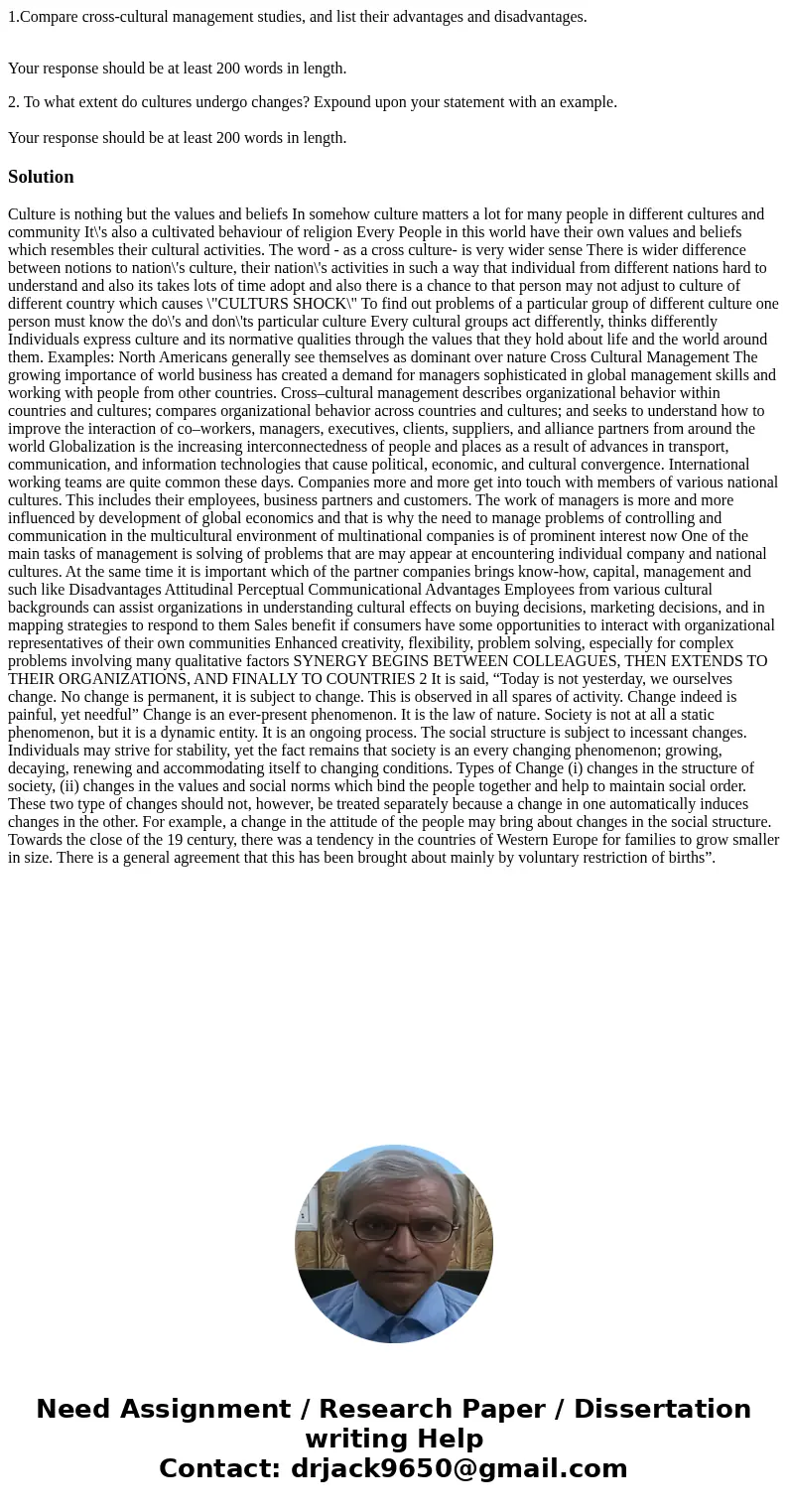1Compare crosscultural management studies and list their adv
1.Compare cross-cultural management studies, and list their advantages and disadvantages.
Your response should be at least 200 words in length.
2. To what extent do cultures undergo changes? Expound upon your statement with an example.
Your response should be at least 200 words in length.
Solution
Culture is nothing but the values and beliefs In somehow culture matters a lot for many people in different cultures and community It\'s also a cultivated behaviour of religion Every People in this world have their own values and beliefs which resembles their cultural activities. The word - as a cross culture- is very wider sense There is wider difference between notions to nation\'s culture, their nation\'s activities in such a way that individual from different nations hard to understand and also its takes lots of time adopt and also there is a chance to that person may not adjust to culture of different country which causes \"CULTURS SHOCK\" To find out problems of a particular group of different culture one person must know the do\'s and don\'ts particular culture Every cultural groups act differently, thinks differently Individuals express culture and its normative qualities through the values that they hold about life and the world around them. Examples: North Americans generally see themselves as dominant over nature Cross Cultural Management The growing importance of world business has created a demand for managers sophisticated in global management skills and working with people from other countries. Cross–cultural management describes organizational behavior within countries and cultures; compares organizational behavior across countries and cultures; and seeks to understand how to improve the interaction of co–workers, managers, executives, clients, suppliers, and alliance partners from around the world Globalization is the increasing interconnectedness of people and places as a result of advances in transport, communication, and information technologies that cause political, economic, and cultural convergence. International working teams are quite common these days. Companies more and more get into touch with members of various national cultures. This includes their employees, business partners and customers. The work of managers is more and more influenced by development of global economics and that is why the need to manage problems of controlling and communication in the multicultural environment of multinational companies is of prominent interest now One of the main tasks of management is solving of problems that are may appear at encountering individual company and national cultures. At the same time it is important which of the partner companies brings know-how, capital, management and such like Disadvantages Attitudinal Perceptual Communicational Advantages Employees from various cultural backgrounds can assist organizations in understanding cultural effects on buying decisions, marketing decisions, and in mapping strategies to respond to them Sales benefit if consumers have some opportunities to interact with organizational representatives of their own communities Enhanced creativity, flexibility, problem solving, especially for complex problems involving many qualitative factors SYNERGY BEGINS BETWEEN COLLEAGUES, THEN EXTENDS TO THEIR ORGANIZATIONS, AND FINALLY TO COUNTRIES 2 It is said, “Today is not yesterday, we ourselves change. No change is permanent, it is subject to change. This is observed in all spares of activity. Change indeed is painful, yet needful” Change is an ever-present phenomenon. It is the law of nature. Society is not at all a static phenomenon, but it is a dynamic entity. It is an ongoing process. The social structure is subject to incessant changes. Individuals may strive for stability, yet the fact remains that society is an every changing phenomenon; growing, decaying, renewing and accommodating itself to changing conditions. Types of Change (i) changes in the structure of society, (ii) changes in the values and social norms which bind the people together and help to maintain social order. These two type of changes should not, however, be treated separately because a change in one automatically induces changes in the other. For example, a change in the attitude of the people may bring about changes in the social structure. Towards the close of the 19 century, there was a tendency in the countries of Western Europe for families to grow smaller in size. There is a general agreement that this has been brought about mainly by voluntary restriction of births”.
 Homework Sourse
Homework Sourse